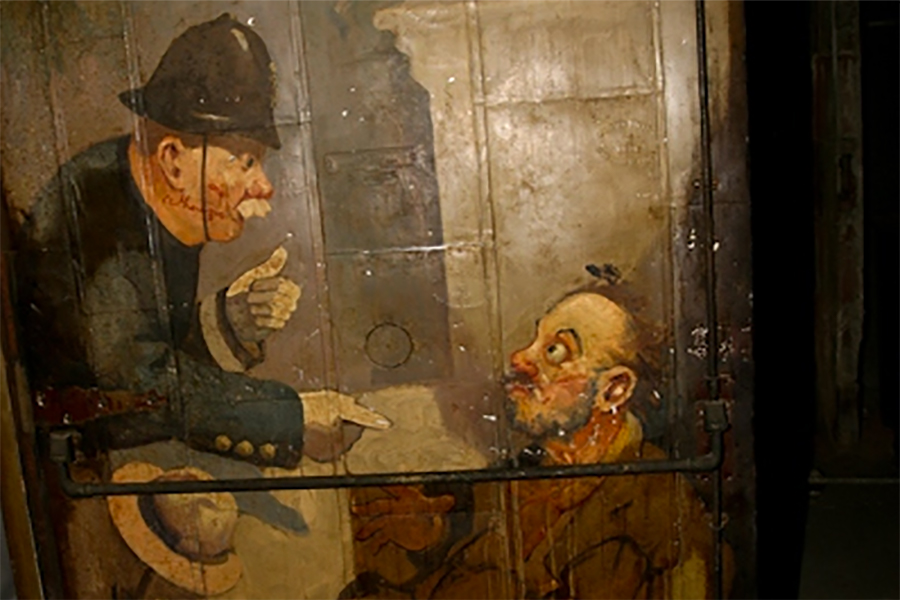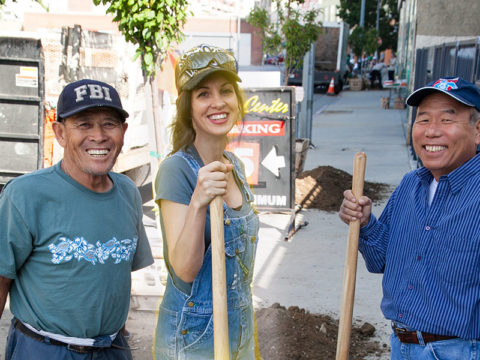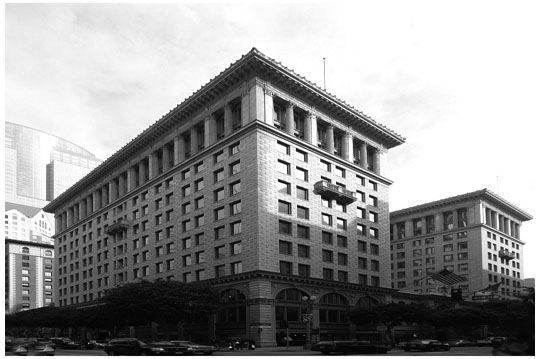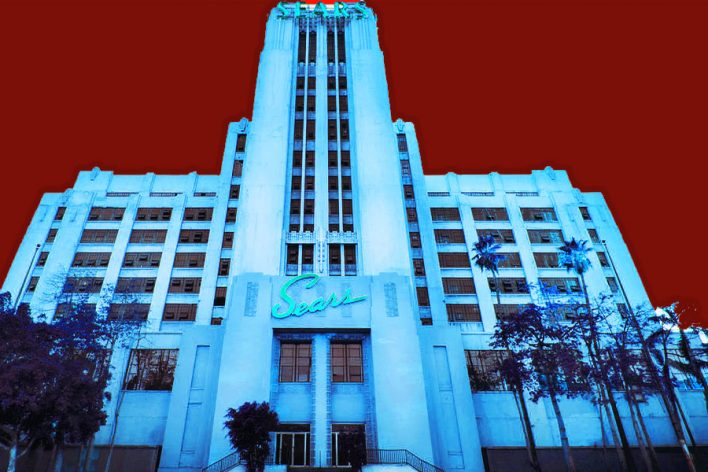
Built in the Art Deco Style, The Sears Building was once one of the company’s major mail order distribution centers with a super humoungous retail store on the ground floor. It was considered a technological paragon at its opening. Today the Sears Building stands as one of the greatest archeological monoliths DTLA has ever witnessed. Here is the true story.

The Sears, Roebuck & Company product distribution Center is located at 2650 E. Olympic Boulevard in Boyle Heights at Eastern LA. The distribution centre was closed in 1992 and the building was sold. The ground floor remains a retail store, but the rest of the huge building is unoccupied. It is 1,800,000 square feet (170,000 m2), and there have been many proposals for its renovation since the mid-1990s.
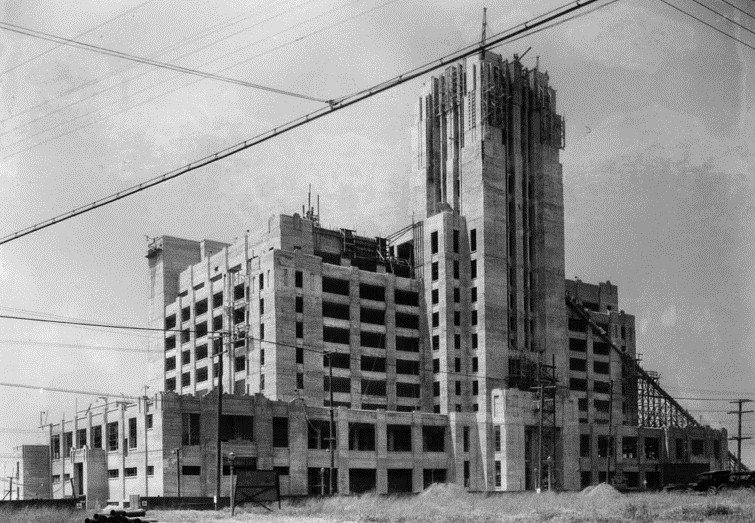
The location of the Sears building was once the outskirts of the Los Angeles Pueblo and the birthplace of Frank Arguello. The grandson of Luis Antonio Arguello, the first Mexican Governor of Alta California, Frank grew up with his father on a ranch which would later turn into Boyle Heights. He later served as a police officer for 4 decades. He died in 1939 at the age of 83.
The Sears Building’s construction was announced in December 1926 by Sears and was done using locally made materials with the exception of the steel window sashes. This was achieved through the use of six steam shovels and a big labor force working day and night shifts. For the cement work, 20 carloads of rock and sand were delivered to the site per day. The Los Angeles Times reported at the building’s completion in late June 1927:
Breaking the Rules
“All records for the erection of a huge structure were believed to have been broken when last week the Scofield Engineering Construction Company turned over the new $5,000,000 department store and mail order house at Ninth Street and Boyle avenue to Sears, Roebuck & Co., having completed this height-limit project in 146 working days, or 171 days of elapsed time.”
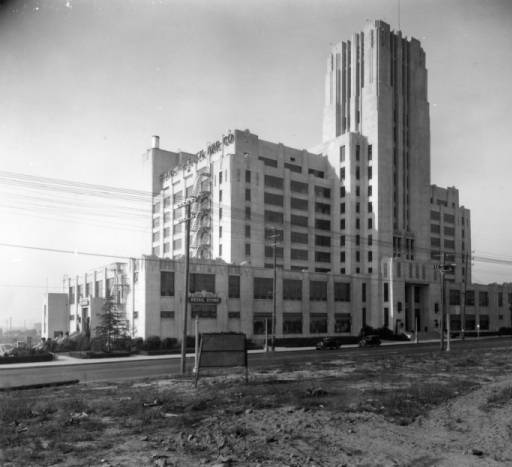
Nine stories and a basement are found in the building, which had a total floor area of approximately 11 acres (45,000 m2). It was one of 9 mail-order distribution centers built by Sears between 1910 and 1929.
Roller Skates and Corkscrews?
To fill orders, employees roller-skated around the facility, picked up items and placed them on corkscrew slides to be delivered by truck or rail. One of the biggest buildings in Los Angeles, the Sears Centre saw more than 100,000 visitors in its first month of existence, excluding customers at the ground-level retail store.
Sign up to receive our popular Get 2 DTLA Newsletter!
The building’s Sears sign and the 226-foot (69 m) Art Deco tower became a “beacon for Eastsiders returning home on area freeways,” and the Los Angeles Conservancy characterized it as “one of the dominant visual icons of the Eastside of Los Angeles”. Many Latino families would head to the Sears weekly.
Haunted Much?
Some locals believe that the building is haunted. Someone had died near the store years ago and it was reported that they were usually seen by store employees. According to Al Tapia, a store manager at the building, it was normal for people to meet there and end up marrying.
In March 1989, 84-year old Grace McIntyre Benton was killed while taking a bus to the Sears store in order to get Easter presents for her grandchildren. After she had bought the presents, she took the bus back home and walked across Boyle Street to go back to Hollenbeck Heights, where her home was located. However, the driver of a pickup truck allegedly failed to notice her at the crosswalk and also missed the red light. According to the LA Times, She was hurled onto the hood of the truck and later died of her injuries at the County-USC Medical Centre. Lula Dixon, Benton’s friend, said: “It just sounds too awful to be true. This has never happened here before, and it is terrible.”
Too Expensive to Run
The closure of the Sears Building in January 1992 took the jobs of 585 full-time and 775 part-time workers. According to the facility’s general manager Tom Shaw, it was expensive to run because of its outdated facilities. A big portion of the problem was that good must often be shipped between the 2 catalogue merchandise buildings which are many blocks apart. The LA shutdowns were part of a cost-cutting program sweeping the company which overall cut 33,000 jobs around USA.
Many employees were upset by the closings, mainly because they had been in the company for a long time. It was also bad for the already declining East Los Angeles area, as the building was considered a good source of jobs and its closing hurt businesses around the area such as restaurants and shops which catered to the Sears workers. One of the difficulties associated with finding a major employer to replace Sears was the age of some of the building’s facilities and the burdensome truck access to the area. However, shortly after the closure, in May 1992, Sears reported its most impressive first-quarter sales in over a decade.
Enter Mark Weinstein
Developer Mark J Weinstein investments took over the building in 2004 and attempted to make it the backbone of a great retail and residential development project. But many residents of Boyle Height resisted this, fearing gentrification, the damaging of small businesses, and an insufficiency of the project. Weinstein later gave up, feeling it was too difficult and time-consuming.
The building was designated a Los Angeles Historic-Cultural Monument on August 10, 2004 and added to the U.S. National Register of Historic Places on April 21, 2006.
Winner by Technical Knockout
Boxer and Boyle Heights resident Oscar de la Hoya, who had shopped at the building with his mother when he was a child, tried to do the revival himself. Jose Huizar, the elected representative of LA’s District 14 which includes Boyle Heights, said that the restoration of the Sears Building has long been a dream for LA: “The project will bring economic opportunities to an area which greatly needs them. The Eastside of LA has traditionally not gotten its fair share of resources and this project will represent an opportunity for everyone in the city to realize and appreciate the valuable resources, rich history, and tremendous economic opportunities this area offers”. However, despite De la Hoya’s bids in 2007 and 2008 with investment from other developers, no deal was achieved.
Downtown Development: Departments to Apartments
Weinstein sold the building to Izek Shormof, an Israeli-born, American real-estate developer, in November 2013. Shormof disclosed “plans to bring it back to life, perhaps with housing, offices and stores”. He further said: “I am excited to breathe new life into this long-neglected building”.

It was announced in 2017 that the Sears Building would begin renovations, with the plans including 1,030 apartments, 95,000 square feet of commercial space, 200,000 square feet of office space and a 250,000 square-foot retail department store. The spaces would incorporate the already open retail store with a creative office area for employees and a limited area for artists, architects and designers. The top area will include swimming pools, a gym, community rooms and athletic courts for residents.
There will also be construction for a new parking area which will have disability parking along with electric vehicle charging stations. Regarding the aesthetic showing of the Sears Building, their will be a landscaped plan and dynamic lighting, with the goal to contribute to LA’s visuals. However, development of the complex is still pending. Downtown Weekly will keep you posted.
[/ihc-hide-content]
